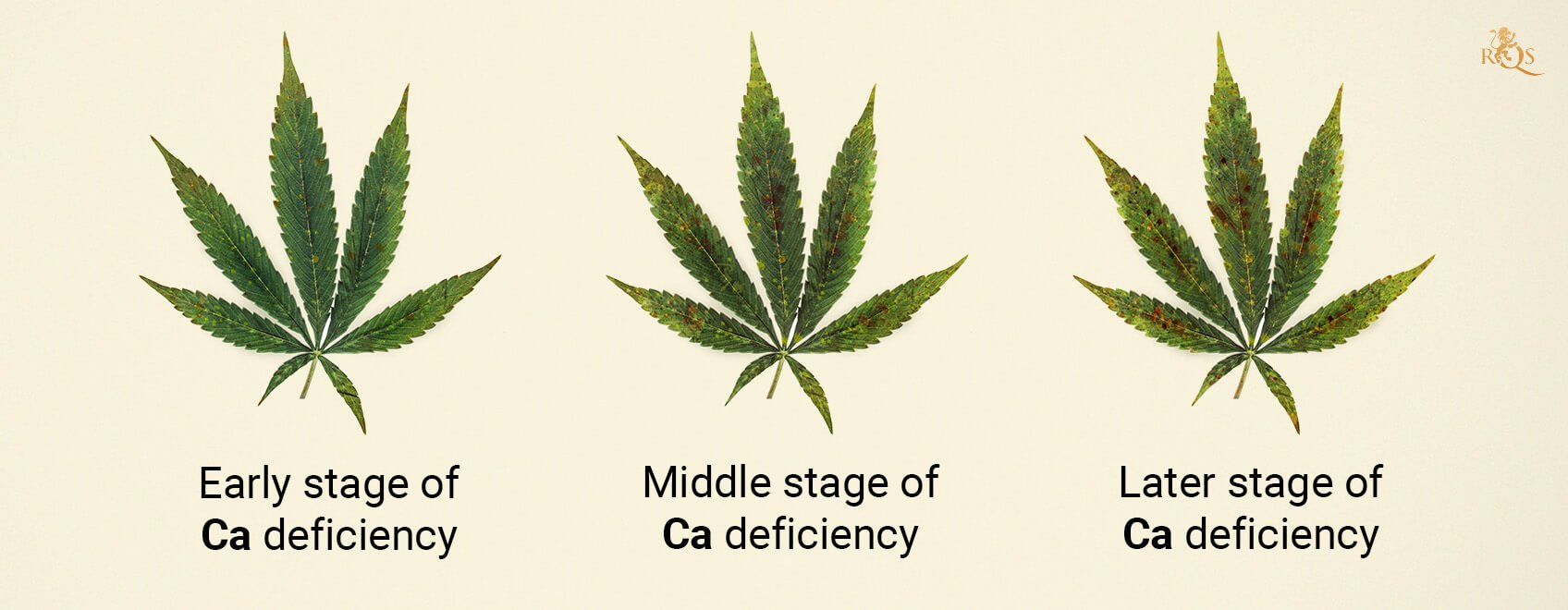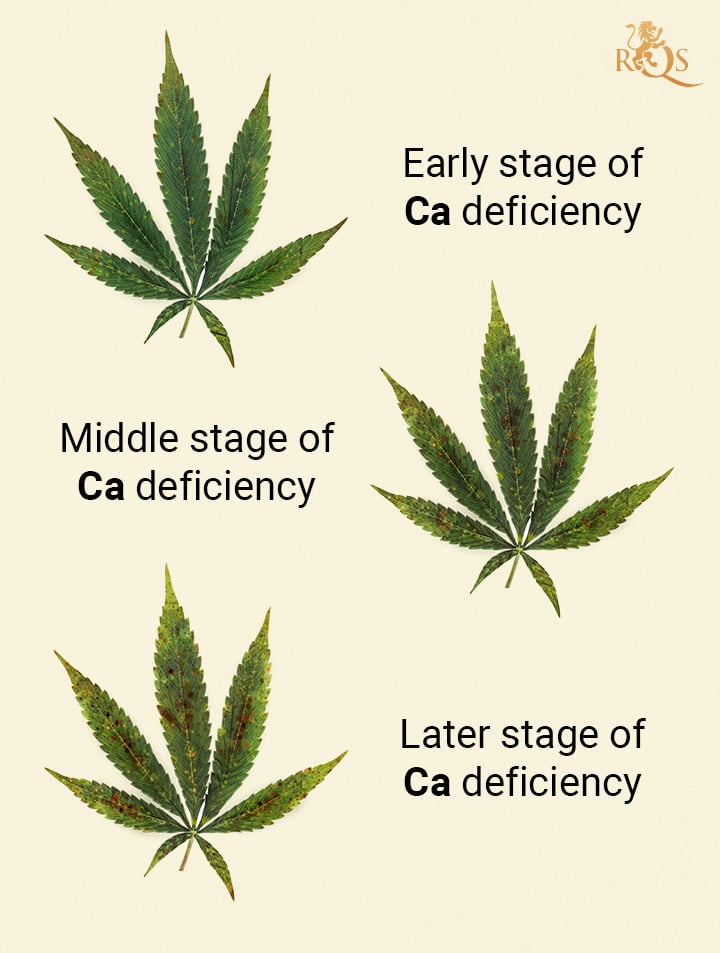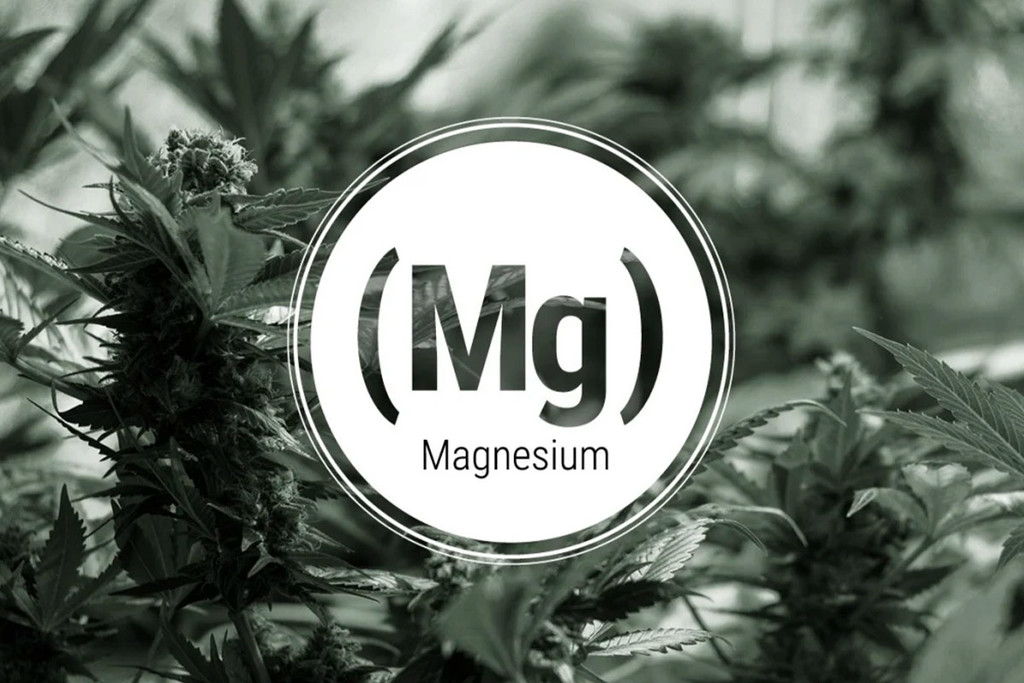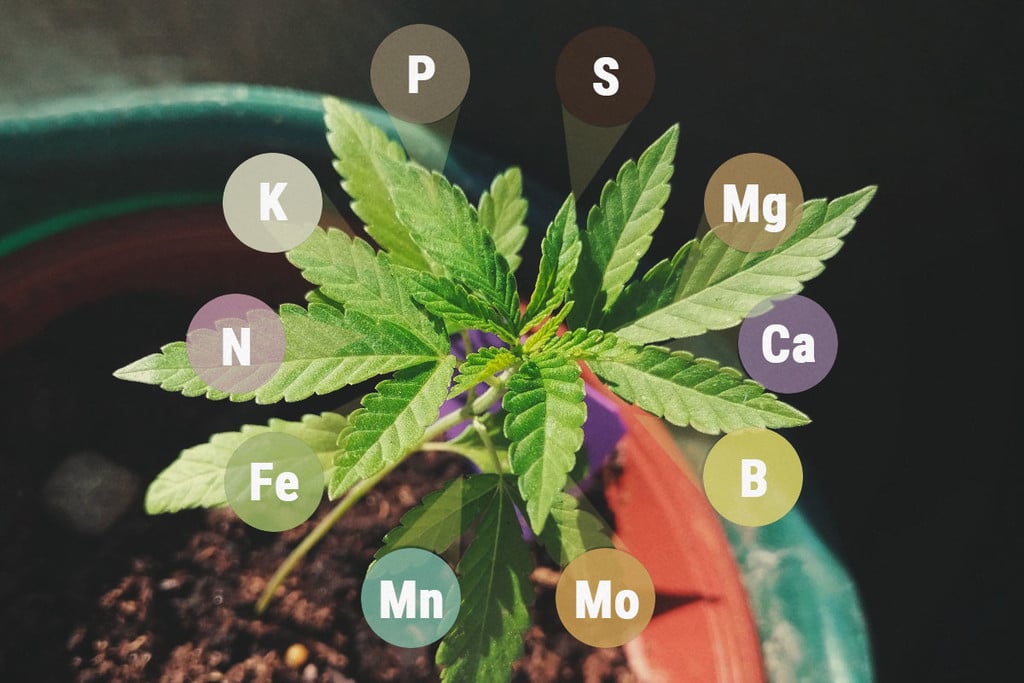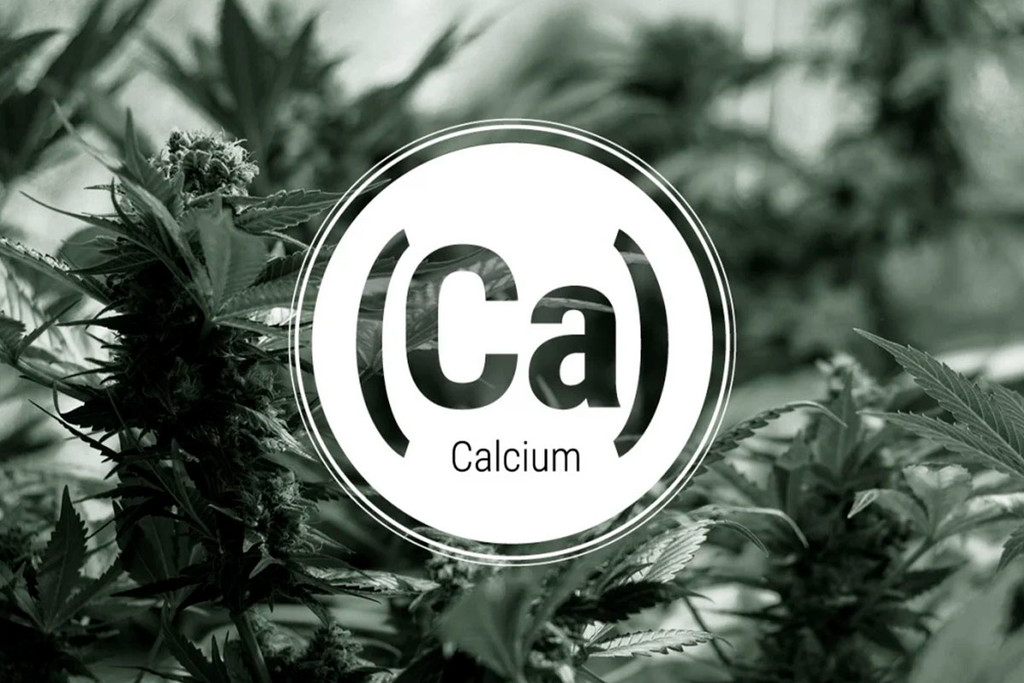.
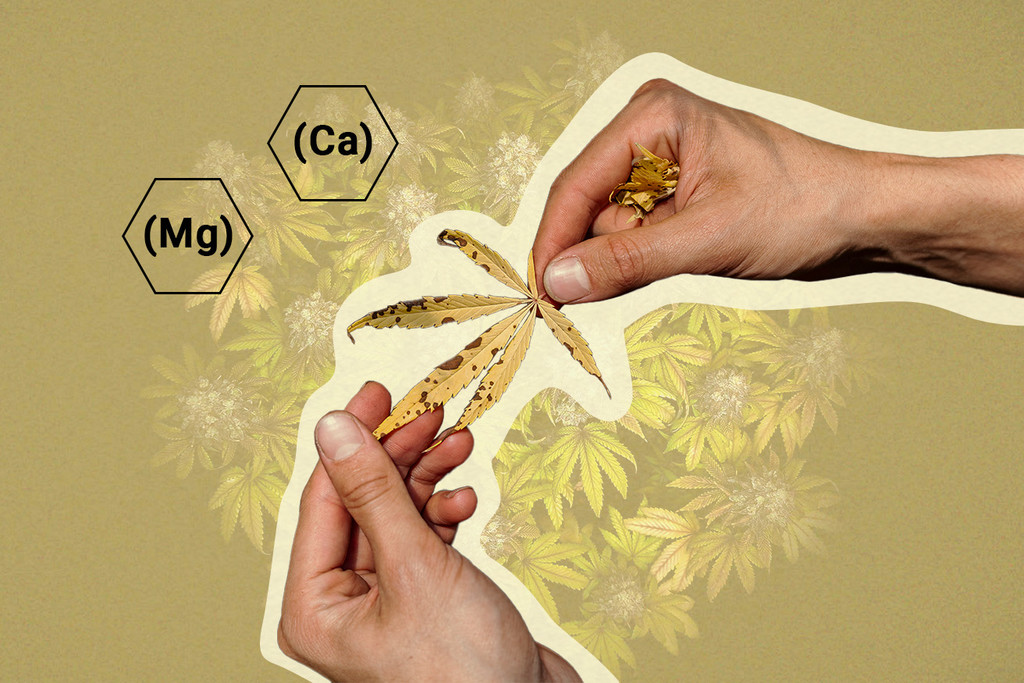
Cal-Mag for Cannabis: All You Need to Know
Many cannabis afflictions seem to get blamed on a cal-mag deficiency. While cannabis depends on many nutrients for optimal health, calcium and magnesium certainly play a fundamental role. You've probably noticed that they almost always appear as a pair in plant supplements. Find out why they work so well together, and how they help plants thrive.
You’ve come across cal-mag supplements while browsing the shelves at gardening shops and weed-centric websites. But why do these elements always show up as a pair? Manufacturers typically include the two in a specific ratio that prevents either of them from becoming locked out of plant roots.
Below, you’ll learn more about why cal-mag is an excellent duo, what they do for cannabis plants, and what the signs of cal-mag deficiencies look like.
Contents:
- Why are calcium and magnesium important for cannabis plants?
- How do cannabis plants process calcium and magnesium?
- Why are calcium and magnesium applied together when growing weed?
- Why is cal-mag deficiency so common in weed plants?
- The symptoms of cal-mag deficiency in weed plants
- Cal-mag deficiencies: know the signs and act accordingly
Why Are Calcium and Magnesium Important for Cannabis Plants?
Cannabis plants require certain nutrients in order to fulfil key physiological functions and thrive. These substances are typically divided into two broad categories: macronutrients and micronutrients. As their names suggest, macronutrients are required in larger amounts while micronutrients are needed in only trace amounts.
The primary macronutrients required by cannabis are:
- Nitrogen
- Phosphorous
- Potassium
The micronutrients needed by cannabis are:
- Boron
- Zinc
- Manganese
- Iron
- Molybdenum
- Chlorine
- Copper
- Nickel
So, where do calcium and magnesium fit into the picture? These two elements are known as secondary macronutrients. They aren’t required in the same quantities as nitrogen, phosphorus, and potassium, but plants are more hungry for them than all of the micronutrients. Find out exactly how they help to direct plant development below.
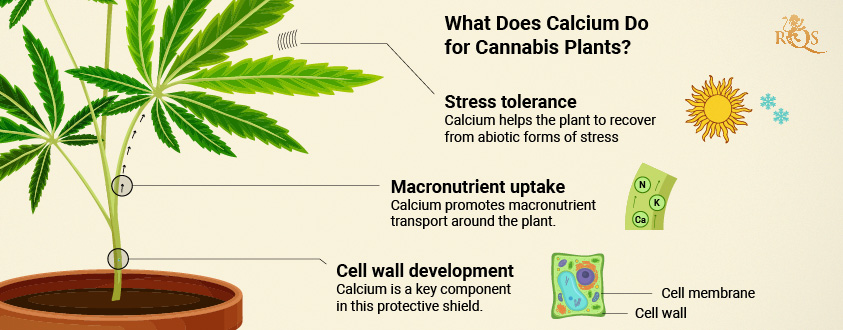
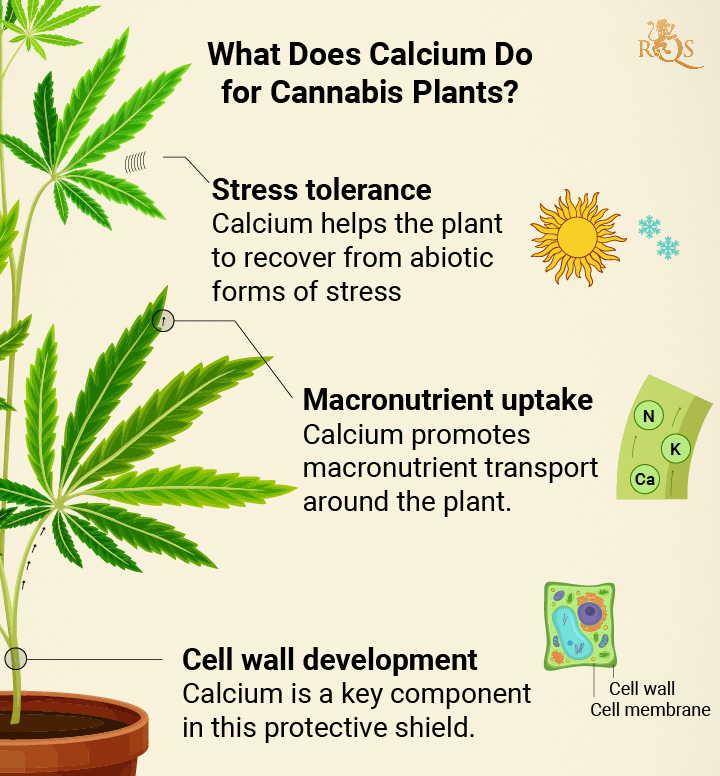
What Does Calcium Do for Cannabis Plants?
As an essential secondary macronutrient, calcium plays several key roles in plant health and growth. These functions include:
- Cell wall development: Unlike animal cells, plant cells have an external cell wall outside of their membrane. This structure provides support and also acts as a barrier against invading pathogens. Calcium serves as a key component in this protective shield.
- Stress tolerance: Calcium steps in to protect plants and help them recover from abiotic (non-living) forms of stress, including drought, heat, and cold.
- Nutrient uptake: Calcium helps cannabis plants to uptake macronutrients, including nitrogen and potassium. The element also helps to transport these substances around plants following uptake.
- Enzyme stimulation: Calcium prompts several enzymes into action that are responsible for key processes, such as creating large proteins.
Get the Pro Guide’s detailed N-P-K charts, nutrient-timing plans, and soil-health tactics to keep every element in balance.
Free Advanced
Growing Guide!
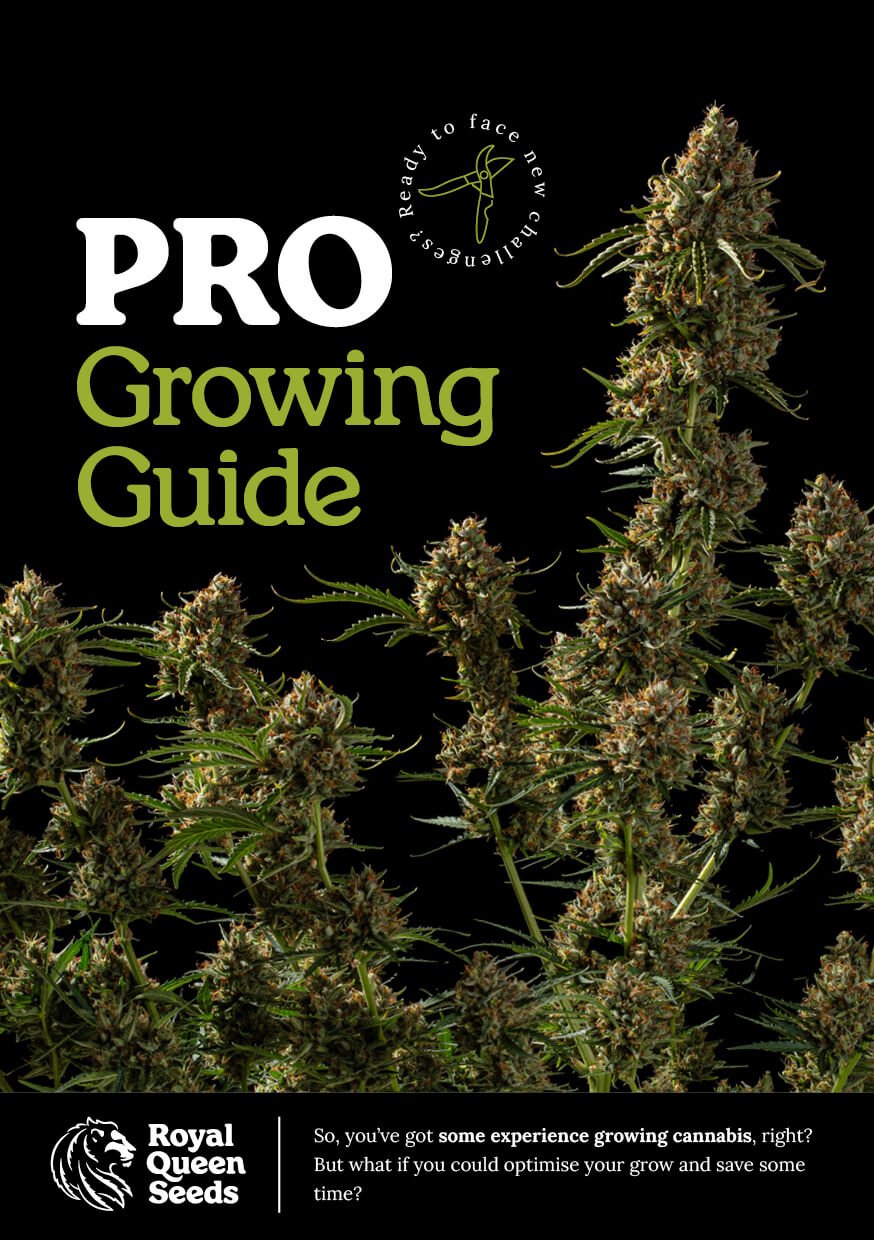
What Does Magnesium Do for Cannabis Plants?
Alongside calcium, magnesium also facilitates vital processes that enable plants to grow properly and create energy. These functions include:
-
Germination: Mg is a component of pectic substances essential for the stability of the cell structure, as well as phytin. Phytin, a low-energy phosphorus accumulator (phytin phosphorus), is of great significance for seed germination.
- Growth: Without magnesium, plants would struggle to grow. The mineral fuels cell division, resulting in large plants and large yields. It also participates in the formation of cell walls, acting as an integrated structural component of ribosomes and the cell nucleus matrix.
- Photosynthesis: Magnesium is the structural basis of the chlorophyll molecule and, therefore, essential in photosynthesis and CO₂ fixation as a coenzyme. Moreover, it is critical to all phosphorylation processes in the plant, promoting the transfer, conversion and accumulation of energy, alongside the synthesis of carbohydrates, proteins, and the cleavage of carbohydrates into pyruvic acid (respiration).
- Energy regulation: Magnesium regulates the energy balance of plants because it is necessary for the formation of bridges between enzymes and the energy carrier, adenosine triphosphate (ATP). Wherever ATP is needed, the presence of Mg is essential. Additionally, the mineral activates several key enzymes, such as Glutamine synthetase (GS), which is vital in binding ammonium to carbohydrates.
- Nutrient uptake: Magnesium also helps plants to uptake other key nutrients, including potassium and phosphorus.
- Regulates hormones and enzymes: In regulating plant hormones, magnesium helps plants to recover from external stressors. Magnesium also influences the formation of RNA and, thus, the transformation of genetic information into proteins. Finally, its moisturising properties support water balance and enzyme efficiency.
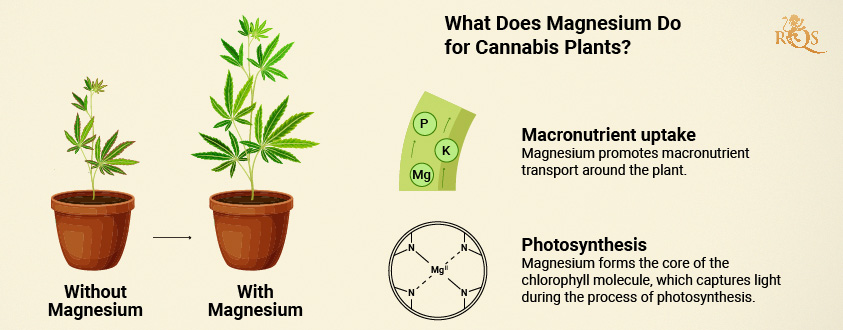
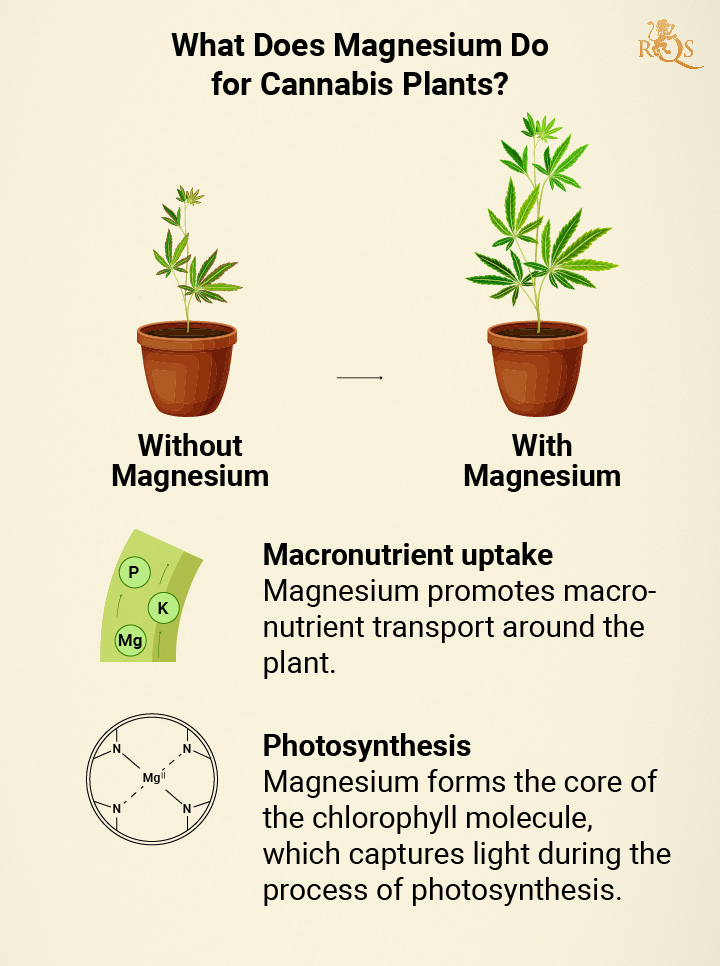
How Do Cannabis Plants Process Calcium and Magnesium?
Cannabis plants first uptake calcium and magnesium through the process of cation exchange[1]. Because both elements are cations, they feature a positive electric charge. In the soil, they cling to clay and organic matter particles that possess a net negative electric charge. In order to dislodge calcium and magnesium, plants pump hydrogen cations into the soil. Because they have a stronger positive charge, they compete with both elements at negatively charged particles and liberate them. From here, plant roots absorb the elements through diffusion.
Once inside, they are transported through the xylem—the vascular network responsible for moving water and dissolved nutrients through plants. They are then deposited where they are needed in order to assist in cellular processes. However, the story doesn’t end here. Magnesium and calcium differ in their mobility. As a mobile nutrient, plants are able to move magnesium around[2] the plant from older tissues to newer tissues. This comes in handy particularly for new tissues when magnesium levels are low. In contrast, plants are unable to move immobile nutrients such as calcium; as such, deficiencies manifest in new growth.
Why Are Calcium and Magnesium Applied Together When Growing Weed?
When shopping for plant nutrients, you’ve probably noticed that calcium and magnesium are often paired together in cal-mag supplements. There are several reasons for this. First, both elements support plants in similar ways; applying them together gives rise to a synergistic relationship. Second, manufacturers include both together because growers can quickly run into trouble when applying them separately.
Adding too much magnesium or calcium can obstruct the optimal uptake of either nutrient. Therefore, getting too heavy-handed with either in isolation can quickly result in deficiencies. Cal-mag supplements provide these nutrients in an ideal ratio of between 3:1–4:1 calcium to magnesium, thereby removing the risk of over-administering either element.
Cal-Mag When Growing in Soil
Before applying cal-mag supplements to the soil, you need to know whether your growing medium requires it. If you’re growing outdoors, a simple soil test will help you determine its nutrient composition. Furthermore, soils with higher levels of clay and organic matter provide higher levels of these elements thanks to superior cation exchange capacity.
If you decide to apply cal-mag to weed plants growing in a container or directly in the ground, it’ll help to take a pH reading first. Your plants might seem starved of these nutrients, but adequate amounts may already exist in the soil. Oftentimes, a pH level that is too high or too low is the culprit, preventing the roots from absorbing available calcium and magnesium. Your weed specimens will have an easier time taking up calcium at a pH of 6.0–7.0, and magnesium at 6.5–7.5. Even if you find you need to add cal-mag, make sure to dial in your pH to optimise absorption.
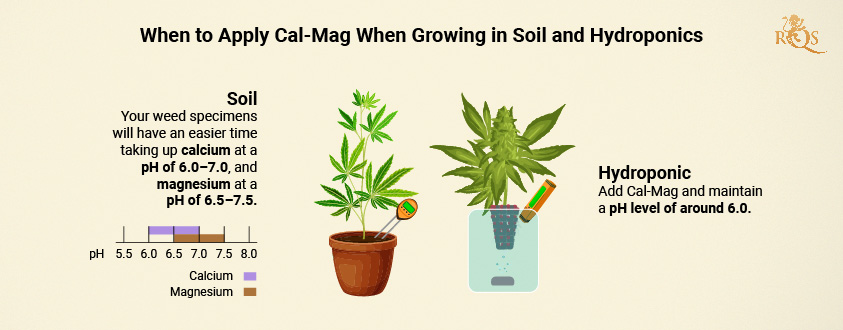
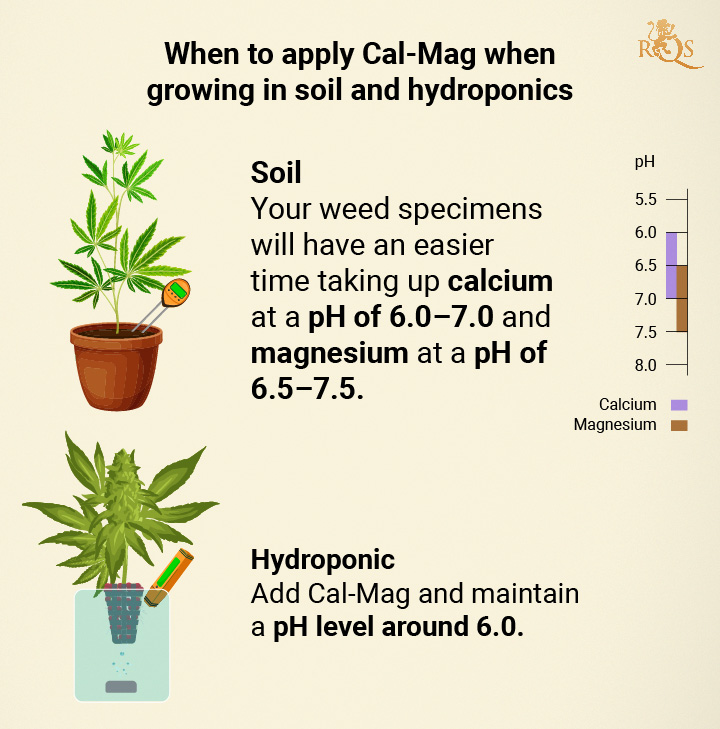
Application of Cal-Mag in Hydroponics
Hydroponic growing necessitates that growers apply all nutrients themselves; therefore, it's necessary to add cal-mag from the get-go. In this scenario, calcium and magnesium form part of a complete nutrient regimen alongside all of the other macronutrients and micronutrients. Add calcium and magnesium at a ratio of 3:1–4:1 and maintain a pH of around 6.0.
Why Is Cal-Mag Deficiency So Common in Weed Plants?
If you frequent cannabis growing forums, you’re likely under the impression that calcium and magnesium deficiency is an epidemic. Almost every picture of a discoloured leaf and withering plant gets a reply of “just hit it with cal-mag, bro”. While this deficiency certainly causes issues in many growing operations, in some circumstances, adding it fails to address the root cause of the issue.
Cal-Mag Deficiency Is a Controversial Topic
Calcium and magnesium deficiencies certainly exist in cannabis, but this hasn’t stopped some growers from taking the hard-line position that it doesn’t. Rather than blaming a lack of cal-mag in soil, they blame environmental variables instead, including poor pH management and an excessive application of other nutrients. If you’re sure that you’ve dialled in your pH and haven’t swamped your plants with potassium, they’ll benefit from a dose of cal-mag.
The Symptoms of Cal-Mag Deficiency in Weed Plants
So, what exactly does a lack of calcium and magnesium look like? Whether your growing medium genuinely lacks these elements or your pH levels are to blame, you can expect similar symptoms. Check out what calcium deficiency and magnesium deficiency look like during each stage of the growing cycle.
Signs of Cal-Mag Deficiency During the Seedling Stage
Plants are extremely vulnerable during the seedling stage. Any sort of deficiency or disease at this time can send plants off on a negative trajectory from the start. The signs of a cal-mag deficiency during the seedling stage include:
- Stunted growth
- Yellow and brown discolouration of leaves
- Weak stems
- Leaves that curl upward or downward
Cal-Mag Deficiency Symptoms During the Vegetative Stage
Cannabis plants put all of their energy into photosynthesising and packing on size during the vegetative phase. A lack of cal-mag during this time can inhibit this process, leading to underwhelming results down the line. Look out for these signs:
- Brown or yellow spots or edges on leaves
- Slow rate of growth
- Crispy leaf tips
What a Lack of Cal-Mag Looks Like in the Flowering Stage
Because calcium and magnesium assist in protein synthesis and energy capture, they are vital during flowering formation. A deficiency during bloom with give rise to the following symptoms:
- Brown and yellow spots on buds
- Brittle leaves
- Small and loose buds
- Small yields
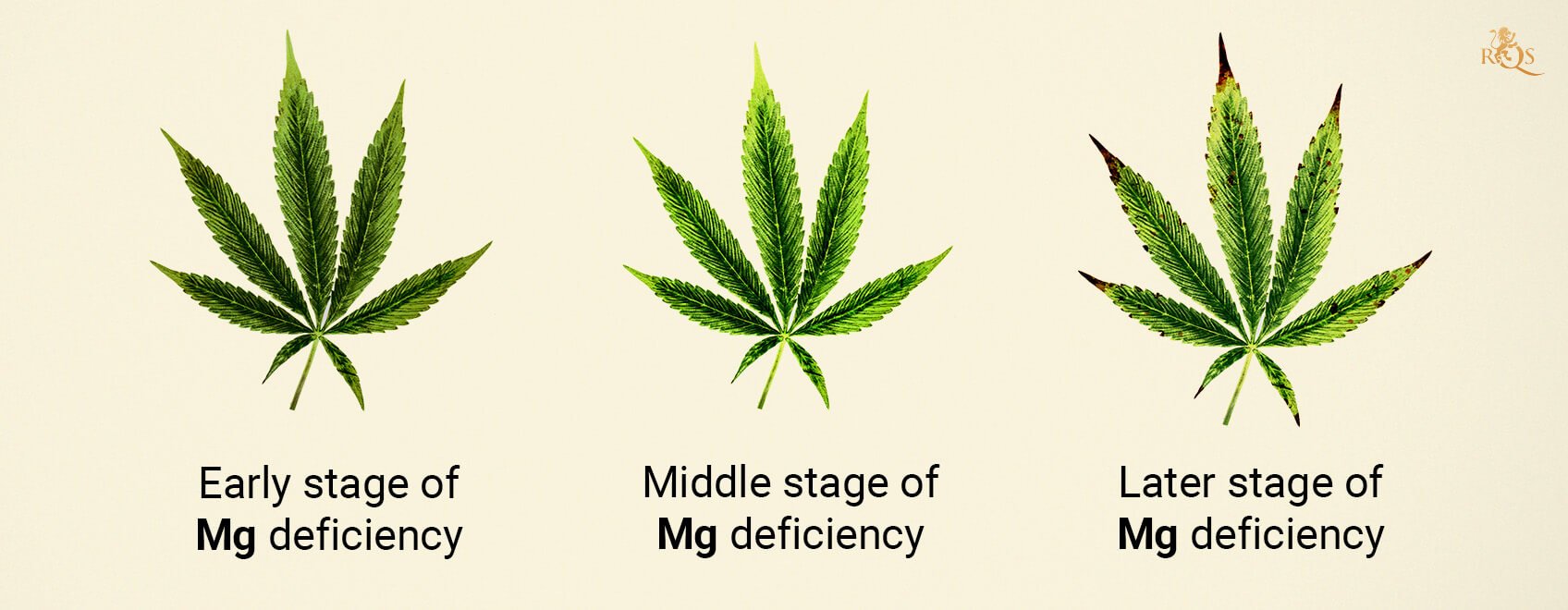
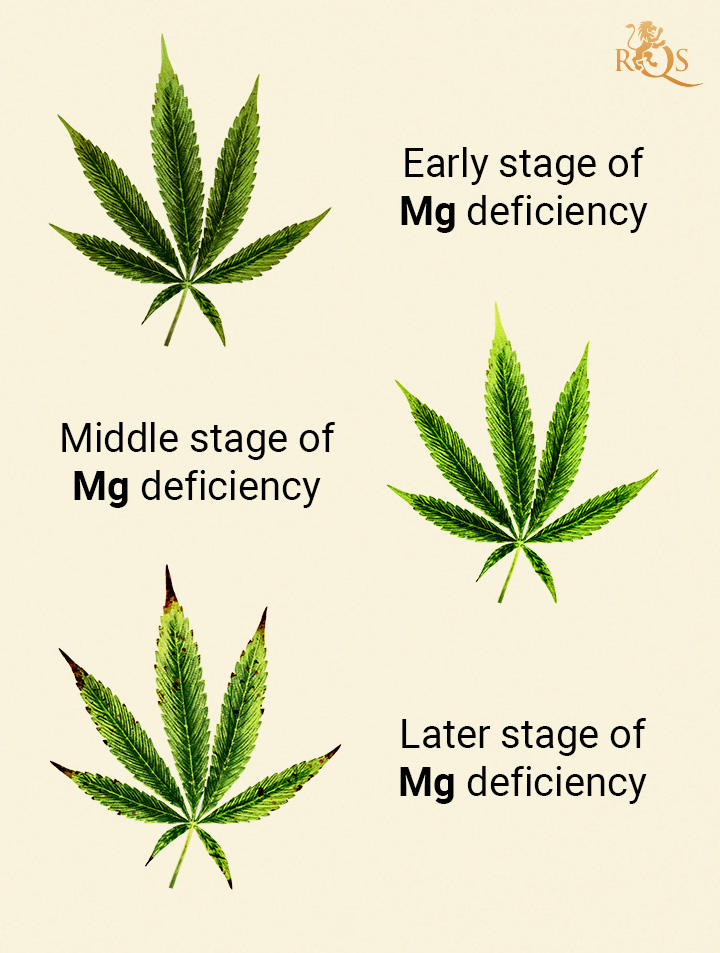
Cal-Mag Deficiencies: Know the Signs and Act Accordingly
You just upgraded your cannabis cultivation knowledge! You’re now aware of why calcium and magnesium almost always occur as a pair in plant supplements. You also know why these elements are so important for plant health, and what the signs of deficiencies look like.
So, before you start pouring cal-mag onto your weed plants, remember to make sure that your pH is within the proper range, and that you’re not adding too much potassium to your growing medium. If everything checks out, then add cal-mag, and watch your plants bounce back in style.
- Cation Exchange Capacity and Base Saturation | UGA Cooperative Extension https://extension.uga.edu
- Understanding Plant Nutrition https://www.austintexas.gov


























